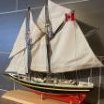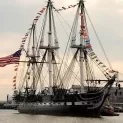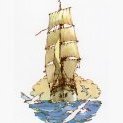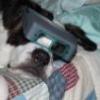-
Posts
2,480 -
Joined
-
Last visited
Reputation Activity
-
 JSGerson got a reaction from Unegawahya in USS Constitution by JSGerson - Model Shipways Kit No. MS2040
JSGerson got a reaction from Unegawahya in USS Constitution by JSGerson - Model Shipways Kit No. MS2040
The third hatchway is part of the stove stack. The grating was framed as the others, but the chimney platform section is 1/32” lower with seven 3/32” x 1/32” boxwood planks. The planks are supported just like the grating with an inside ledge. In actuality, the stack passes through the platform to the stove below. My first thought was to recreate the stack using brass tubing, but the stack is oval in cross section, and it tapers towards the top. Even if I had a metal lathe, which I don’t, I have no idea how I would/could fabricate a hollow stack of that shape. The kit’s casting is pretty accurate, so I went with it. Until I removed the kit’s cast stack from the kit box, I thought it would sit flat upon the platform. But the cast piece has a substantial plug/protrusion that requires an oval hole in the slats.
If I were to cut/drill a hole through the slats, the platform would collapse. Therefore, I glued a piece of 1/32” plywood under the slats for support. Because this a solid cast part, I drilled out the stack’s mouth just enough to give the illusion the stack pipe was hollow. Of course, just to make things more interesting, the plug is not circular but oval in cross section, and the stack’s base flange is supposed to be recessed into the platform. I decided that the recessed flange was a bit much. A lot of work for not much visual gain and a high probability I could really mess up and have a “re-do” on my hands. The drilling of the plug hole went smoothly. Using successive larger bits, a pilot hole was expanded to the proper width and then filed to get the proper oval shape. A couple of planks tried to come loose but the slight damage was covered up by the stack’s base flange.
The next item fabricated for the stack was the spark arrester in front of the stack mouth. It sits very close to the mouth and blocks a direct view inside the mouth enabling my hollow stack illusion.
-
 JSGerson got a reaction from Unegawahya in USS Constitution by JSGerson - Model Shipways Kit No. MS2040
JSGerson got a reaction from Unegawahya in USS Constitution by JSGerson - Model Shipways Kit No. MS2040
This was a tricky bit. Ideally, I would have drilled a hole on either side of the arrestor plate, inserted some fine diameter rods into the holes and soldered them in place. The immediate problem is that I don’t have a fine drill bit that can drill into metal, even a soft metal like brass. I opted to cut a slit in lieu of holes and hoped the solder would fill in the gaps.
I cut 0.005” thick brass place to the oval shape and cut two pieces of 0.018” dia. music wire to length. Using silver solder paste with a butane torch, these were soldered as shown below. It worked like a charm until I tried to remove it from the wood block, and it fell apart. It took numerous attempts and a slightly different, more robust setup, till it held together. The excess solder was then filed off.
-
 JSGerson got a reaction from Unegawahya in USS Constitution by JSGerson - Model Shipways Kit No. MS2040
JSGerson got a reaction from Unegawahya in USS Constitution by JSGerson - Model Shipways Kit No. MS2040
This brings to light that some or all my support knees may not be positioned properly. I may have to fudge a bunch more. Because the main grating on the spar deck (under the pinnace) will be partially opened to allow viewing of the gun deck, the supporting beams below it must be aligned with the grating’s cross beams precisely. For that reason, I will pause installing the additional gun deck bitts and previously fabricated furniture (i.e., capstan, pumps, casks, etc.) until I have fabricated the spar deck hatchways and gratings. They will be dry fitted to ensure the key beams below are properly positioned.
Where to begin? I had several false starts trying to figure out how to fabricate the various grating using Robert Hunt’s practicum. Per section 4.2.2 Hatch Coaming Framework of the practicum, I installed the framing supports for the bowsprit hatch and foremast hatch just aft of it. These supports will allow the hatchways to be dry fitted.
-
 JSGerson got a reaction from Unegawahya in USS Constitution by JSGerson - Model Shipways Kit No. MS2040
JSGerson got a reaction from Unegawahya in USS Constitution by JSGerson - Model Shipways Kit No. MS2040
To install the wood column at the forward end of the furthest aft gun deck hatchway, the spar deck beam had to be installed directly overhead of that column so it could support the beam. This beam is also supported at its ends by knee braces previously attached to the bulwarks which the gun riggings are now attached. Unfortunately, when the beam was dry fitted on the knees, the beam did not center directly over the column. It was about a beam’s width aft off. To dismantle and reposition the knees meant removing the gun rigging as well. I could do that or fudge it. Because where the knees and the beam ends join will be hidden when the partial spar deck is installed, the beam was moved forward just enough to get it centered over the column, just not sitting directly on the knees.
-
 JSGerson got a reaction from PaddyO in USS Constitution by Der Alte Rentner - Model Shipways - 1/76
JSGerson got a reaction from PaddyO in USS Constitution by Der Alte Rentner - Model Shipways - 1/76
Woodartist: I feel flattered. Remember, the Conny is only my second square rigged ship and third wooden model. So take everything I say/do with a grain of salt. I am an experience amateur, not an expert. It is why I explain what I do so that the reader may avoid any mistakes I may have made.
Jon
-
 JSGerson got a reaction from mtbediz in USS Constitution by Der Alte Rentner - Model Shipways - 1/76
JSGerson got a reaction from mtbediz in USS Constitution by Der Alte Rentner - Model Shipways - 1/76
Woodartist: I feel flattered. Remember, the Conny is only my second square rigged ship and third wooden model. So take everything I say/do with a grain of salt. I am an experience amateur, not an expert. It is why I explain what I do so that the reader may avoid any mistakes I may have made.
Jon
-
 JSGerson got a reaction from Stevenleehills in USS Constitution by Der Alte Rentner - Model Shipways - 1/76
JSGerson got a reaction from Stevenleehills in USS Constitution by Der Alte Rentner - Model Shipways - 1/76
I do something similar. I've copied every Constitution log I've ever followed, some good, some not so good: 38 on going; 25 now completed; 26 dormant, logs never completed. This is how I've been able to locate information quickly from these builders. I can do word searches on their complete logs without having to go page by page on the websites. (BTW, I don't trust websites; they crash, disappear, and change location of their pages.) Should there be something interesting like an impressive jig or construction method I may want to use, I will copy and paste that portion of the log as a separate document and file it in the appropriate subject folder for easy reference. I also collect images of the real ship. A lot of the images you can't find directly with a search engine I gotten by looking for "A" and finding "B". They are all sorted into individual subject folders. I've got about 1,400 images; and the US Navy plans from various sources. Yeah, so I guess I am the reference guy.
Jon
-
 JSGerson got a reaction from catopower in USS Constitution by Avi - BlueJacket Shipcrafters - 1:96
JSGerson got a reaction from catopower in USS Constitution by Avi - BlueJacket Shipcrafters - 1:96
If you don't need to make the rudder move, make your own pseudo hinges and pin the rudder to to the post. Or, if you do want the moveable rudder, that will take some skill and creativeness to make your own working gudgeons and pintles. My MS model is a larger scale (1:76.8) and I made the working rudder with some effort. I don't know if I would have tried it at 1:96.
Jon
-
 JSGerson got a reaction from Bill Morrison in USS CONSTITUTION by Brian Falke - BlueJacket Shipcrafters - Scale 1:96
JSGerson got a reaction from Bill Morrison in USS CONSTITUTION by Brian Falke - BlueJacket Shipcrafters - Scale 1:96
Nice save. In your situation, I've would have handled it in the exact same manner. Out of curiosity, what kind of wood is your hull planking made of? It does present a unique visual pattern. Will it eventually be covered with a second layer of planking and/or paint and copper plate(?).
Jon
-
 JSGerson got a reaction from mtbediz in USS Constitution by Der Alte Rentner - Model Shipways - 1/76
JSGerson got a reaction from mtbediz in USS Constitution by Der Alte Rentner - Model Shipways - 1/76
I do something similar. I've copied every Constitution log I've ever followed, some good, some not so good: 38 on going; 25 now completed; 26 dormant, logs never completed. This is how I've been able to locate information quickly from these builders. I can do word searches on their complete logs without having to go page by page on the websites. (BTW, I don't trust websites; they crash, disappear, and change location of their pages.) Should there be something interesting like an impressive jig or construction method I may want to use, I will copy and paste that portion of the log as a separate document and file it in the appropriate subject folder for easy reference. I also collect images of the real ship. A lot of the images you can't find directly with a search engine I gotten by looking for "A" and finding "B". They are all sorted into individual subject folders. I've got about 1,400 images; and the US Navy plans from various sources. Yeah, so I guess I am the reference guy.
Jon
-
 JSGerson got a reaction from GGibson in USS Constitution by Der Alte Rentner - Model Shipways - 1/76
JSGerson got a reaction from GGibson in USS Constitution by Der Alte Rentner - Model Shipways - 1/76
I do something similar. I've copied every Constitution log I've ever followed, some good, some not so good: 38 on going; 25 now completed; 26 dormant, logs never completed. This is how I've been able to locate information quickly from these builders. I can do word searches on their complete logs without having to go page by page on the websites. (BTW, I don't trust websites; they crash, disappear, and change location of their pages.) Should there be something interesting like an impressive jig or construction method I may want to use, I will copy and paste that portion of the log as a separate document and file it in the appropriate subject folder for easy reference. I also collect images of the real ship. A lot of the images you can't find directly with a search engine I gotten by looking for "A" and finding "B". They are all sorted into individual subject folders. I've got about 1,400 images; and the US Navy plans from various sources. Yeah, so I guess I am the reference guy.
Jon
-
 JSGerson got a reaction from Der Alte Rentner in USS Constitution by Der Alte Rentner - Model Shipways - 1/76
JSGerson got a reaction from Der Alte Rentner in USS Constitution by Der Alte Rentner - Model Shipways - 1/76
Just about every surface of my model is covered with something, be it copper, paint, or stain. I have not used polyurethane (Wipe-On Poly)...yet. When I use paint, it's on bare wood so it soaks into the surface. I've used basswood, boxwood, and pear wood so far. The only wood I could have used the poly was the pear wood which was already the correct color I wanted. I didn't use it on the couple of wooden columns and bitts I made with it so far which are barely visible, but I may go back and touch them up with it.
And yes I too get cases of "analysis paralysis."
Jon
-
 JSGerson got a reaction from Stevenleehills in Constitution by Geoff Matson - Model Shipways 2040 - 1/76 scale
JSGerson got a reaction from Stevenleehills in Constitution by Geoff Matson - Model Shipways 2040 - 1/76 scale
As near as I can tell, the tapering is subtle, but I will check it out in more detail when I get to that stage' Peter, here are a bunch of overhead shots of the stern. Any tapering is hard to see in these photos.
-
 JSGerson got a reaction from Stevenleehills in USS Constitution by JSGerson - Model Shipways Kit No. MS2040
JSGerson got a reaction from Stevenleehills in USS Constitution by JSGerson - Model Shipways Kit No. MS2040
When I first started making models around age 10, obviously they were plastic, but I never liked the simple ones. I always chose the ones with the most parts, so most of the time I made modern ships and maybe a few cars and planes. No one I knew made models and therefore I was self taught. I wasn't even aware that you could buy paint. So although, I learned to assemble the kits fairly well they never looked as good as what I saw on the box. Boy, have times changed.
Jon
-
 JSGerson got a reaction from mtbediz in USS Constitution by Der Alte Rentner - Model Shipways - 1/76
JSGerson got a reaction from mtbediz in USS Constitution by Der Alte Rentner - Model Shipways - 1/76
Just about every surface of my model is covered with something, be it copper, paint, or stain. I have not used polyurethane (Wipe-On Poly)...yet. When I use paint, it's on bare wood so it soaks into the surface. I've used basswood, boxwood, and pear wood so far. The only wood I could have used the poly was the pear wood which was already the correct color I wanted. I didn't use it on the couple of wooden columns and bitts I made with it so far which are barely visible, but I may go back and touch them up with it.
And yes I too get cases of "analysis paralysis."
Jon
-
 JSGerson got a reaction from mtbediz in USS Constitution by JSGerson - Model Shipways Kit No. MS2040
JSGerson got a reaction from mtbediz in USS Constitution by JSGerson - Model Shipways Kit No. MS2040
When I first started making models around age 10, obviously they were plastic, but I never liked the simple ones. I always chose the ones with the most parts, so most of the time I made modern ships and maybe a few cars and planes. No one I knew made models and therefore I was self taught. I wasn't even aware that you could buy paint. So although, I learned to assemble the kits fairly well they never looked as good as what I saw on the box. Boy, have times changed.
Jon
-
 JSGerson got a reaction from Geoff Matson in Constitution by Geoff Matson - Model Shipways 2040 - 1/76 scale
JSGerson got a reaction from Geoff Matson in Constitution by Geoff Matson - Model Shipways 2040 - 1/76 scale
As near as I can tell, the tapering is subtle, but I will check it out in more detail when I get to that stage' Peter, here are a bunch of overhead shots of the stern. Any tapering is hard to see in these photos.
-
 JSGerson got a reaction from Unegawahya in USS Constitution by JSGerson - Model Shipways Kit No. MS2040
JSGerson got a reaction from Unegawahya in USS Constitution by JSGerson - Model Shipways Kit No. MS2040
Now for the tricky part, the inside transition curve between the two grating frames. This curve was initially fabricated by trimming off the corners to start the transition. Then, using a router bit on my Dremel tool, the router bit allowed me to carve the inside curve of the 7/32” x 3/32” boxwood using the side of the bit as the cutting tool. This was done by hand, no drill stand or jig was used. To create the curved beveled edging was even tricker due to its size. I was trying to emulate a curved piece of beveled 3/32” x 1/32” boxwood because bending a strip of boxwood 90° in that short of distance was neigh impossible (for me at least). The curve was created by cutting a separate piece of boxwood to the basic shape and finished by carving by hand, again with the router bit fitted Dremel and assorted files. I suppose if I had a milling machine, it would have been more precise, but I think the results I got work just as well.
-
 JSGerson got a reaction from PaddyO in Constitution by Geoff Matson - Model Shipways 2040 - 1/76 scale
JSGerson got a reaction from PaddyO in Constitution by Geoff Matson - Model Shipways 2040 - 1/76 scale
As near as I can tell, the tapering is subtle, but I will check it out in more detail when I get to that stage' Peter, here are a bunch of overhead shots of the stern. Any tapering is hard to see in these photos.
-
 JSGerson got a reaction from Der Alte Rentner in USS Constitution by JSGerson - Model Shipways Kit No. MS2040
JSGerson got a reaction from Der Alte Rentner in USS Constitution by JSGerson - Model Shipways Kit No. MS2040
When I first started making models around age 10, obviously they were plastic, but I never liked the simple ones. I always chose the ones with the most parts, so most of the time I made modern ships and maybe a few cars and planes. No one I knew made models and therefore I was self taught. I wasn't even aware that you could buy paint. So although, I learned to assemble the kits fairly well they never looked as good as what I saw on the box. Boy, have times changed.
Jon
-
 JSGerson got a reaction from PaddyO in USS Constitution by JSGerson - Model Shipways Kit No. MS2040
JSGerson got a reaction from PaddyO in USS Constitution by JSGerson - Model Shipways Kit No. MS2040
When I first started making models around age 10, obviously they were plastic, but I never liked the simple ones. I always chose the ones with the most parts, so most of the time I made modern ships and maybe a few cars and planes. No one I knew made models and therefore I was self taught. I wasn't even aware that you could buy paint. So although, I learned to assemble the kits fairly well they never looked as good as what I saw on the box. Boy, have times changed.
Jon
-
 JSGerson got a reaction from usedtosail in USS Constitution by JSGerson - Model Shipways Kit No. MS2040
JSGerson got a reaction from usedtosail in USS Constitution by JSGerson - Model Shipways Kit No. MS2040
Now for the tricky part, the inside transition curve between the two grating frames. This curve was initially fabricated by trimming off the corners to start the transition. Then, using a router bit on my Dremel tool, the router bit allowed me to carve the inside curve of the 7/32” x 3/32” boxwood using the side of the bit as the cutting tool. This was done by hand, no drill stand or jig was used. To create the curved beveled edging was even tricker due to its size. I was trying to emulate a curved piece of beveled 3/32” x 1/32” boxwood because bending a strip of boxwood 90° in that short of distance was neigh impossible (for me at least). The curve was created by cutting a separate piece of boxwood to the basic shape and finished by carving by hand, again with the router bit fitted Dremel and assorted files. I suppose if I had a milling machine, it would have been more precise, but I think the results I got work just as well.
-
 JSGerson got a reaction from Unegawahya in USS Constitution by JSGerson - Model Shipways Kit No. MS2040
JSGerson got a reaction from Unegawahya in USS Constitution by JSGerson - Model Shipways Kit No. MS2040
Saving the main hatchways and gratings for last, I worked next on the double grating next to the ship’s wheel. The larger of the two gratings is a hatchway, and the smaller one covers a skylight. I never found an image where that grating was removed to revealed the skylight below. As a matter of fact, I never found a decent image of the double grating as a whole. However, this is where I realized I made a mistake in choosing the kit grating I used for the foremast hatchway. I used the one assigned for the skylight, a 7x5 grid instead of the proper 7x6 grid.
-
 JSGerson got a reaction from Geoff Matson in Constitution by Geoff Matson - Model Shipways 2040 - 1/76 scale
JSGerson got a reaction from Geoff Matson in Constitution by Geoff Matson - Model Shipways 2040 - 1/76 scale
I've been following your conversations from afar about tapering the deck planks and I'm confused. I understand tapering of the hull planks because you're working on a curved surface. Just about every one of my planks near the the bow and stern were tapered. But the only tapering I've seen on the deck planks is where the planks converge and/or nibbed are at the bow. None the of images I've seen of the actual Constitution deck planks converge. Or are you talking about something else?
Jon
-
 JSGerson got a reaction from Unegawahya in USS Constitution by JSGerson - Model Shipways Kit No. MS2040
JSGerson got a reaction from Unegawahya in USS Constitution by JSGerson - Model Shipways Kit No. MS2040
I also noticed that the painting scheme of the actual ship has again changed. You will notice the frames of all the hatchways presently have black trim, whereas prior to the 2015-2017 restoration, the frames had natural wood finishes. Since my model is based on the present ship configuration (with some exceptions), I painted these last two frames with black trim now because the interior elements had to be painted during fabrication and to see how they would look. The others will be painted later.









